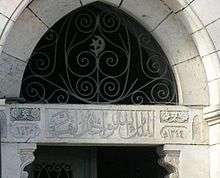Emek Refaim
Emek Refaim (Hebrew: עמק רפאים) is the German Colony, a neighborhood in Jerusalem, as well as its main street. It takes its name from the biblical Valley of Rephaim which began its descent from Jerusalem here.


Etymology
Emek Refa’im can be translated as either "the valley of the ghosts" or "the valley of the giants." The 2nd-century CE Aramaic Targum of Onkelos translates the words as meshar gibaraya, or "plain of the mighty." Jerome’s 4th-century Latin Vulgate translates the phrase as "vallis Raphaim," and the English King James version follows the Jewish commentators, translating it as "the valley of the giants."[1]
History
Outside of the ancient city of Jerusalem, but inhabited by villagers from the tribe of Judah in the first and second Temple periods.
The first residents of Emek Refaim in modern times were German Templers, who settled there in the 19th century. Biblical inscriptions in German Fraktur script can still be seen on the lintels of some of the homes. As enemy aliens, the Templers were interned and later deported by the British during World War II. They built one- and two-storey houses similar in appearance to the homes they left in Württemberg.
Architecture
Many of the buildings on Emek Refaim date from Ottoman and British Mandate times. Some of the distinctive German Templer buildings are still standing, as are elegant villas that belonged to wealthy Arabs before the establishment of the State of Israel.
Some homes in the area were abandoned by local Arabs or expropriated after 1948,[2] and many issues of property ownership and displacement have yet to be resolved. A former Arab resident of the Bauerle House, located at 10 Emek Refaim (originally built by the Templers), wrote about a painful visit to her home after 1967.[3]
A movie theater, Smadar, on the corner of Emek Refaim and Lloyd George Street, was built during the British Mandate, when it was known as the Regent or the Orient. At the corner of Emek Refaim, on a hill overlooking the Hinnom Valley, is the Scottish Church of St. Andrew's, built in 1927 and incorporating local Armenian tile-work. Similar tiling can be seen on the facades of some buildings on Emek Refaim.
The residents of Emek Refaim have banded together to protest plans to build a hotel and residential towers in the area, which would affect the historic character of the neighborhood. The protest was partially successful, in that the small grove next to the building will be preserved, and the planned height of the hotel was reduced from the original 14 to 7 floors - making it - The Orient Hotel by Dan Hotels, the largest and tallest structure on Emek Refaim.
As of 2016, planners for the Jerusalem Light Rail network have announced the possibility that a rail line will pass along Emek Refaim, which will be closed to traffic in both directions. This has sparked another wave of protests, which have in turn prompted a public debate on alternative routes that would leave the street as-is.
Restaurants
Emek Refaim is home to a variety of restaurants and cafes which are mainly, if not all, kosher certified establishments (reflecting the largely religious population in the area). Two chains of restaurants (Burgers Bar and Caffit) had their first branches on this street[4] before they expanded across the country with additional locations.
- Aldo - Ice cream
- Bagel Cafe
- Burgers Bar
- Caffit
- Falafel Adir
- Focaccia Bar
- Pompidou
- Roza
- Sushi Rehavia
- Waffle Bar
- Waffle Factory
References
- "On Language: Ghostly". Forward.com. 2004-03-26. Retrieved 2012-06-09.
- JUF News : The man on the roof
- "Hala Sakakini reminisces". Alnakba.org. Archived from the original on 2013-03-26. Retrieved 2012-06-09.
- "Emek Refaim Restaurants".